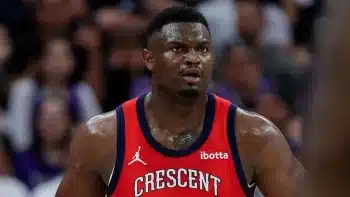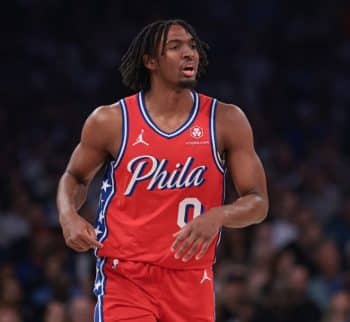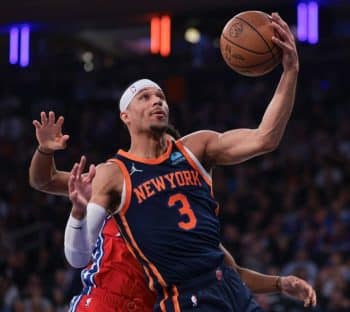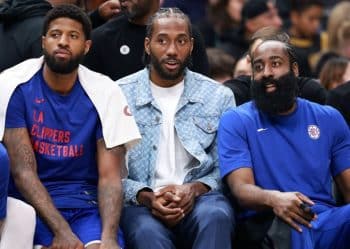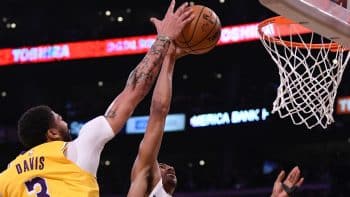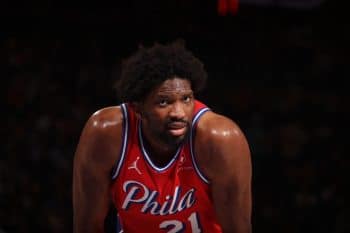NBA
The NBA’s Best Out-of-Bounds Sets and Coaches

Evaluating the day-in, day-out job of an NBA coach from a media perch will always be a supremely incomplete exercise. There’s just a ton of stuff that goes on within the confines of a given coach’s responsibilities that we’ll never see or hear about, and often some of the details herein are the biggest differentiators between what makes a good coach and a bad one.
There are bits of visible minutiae that allow us to judge a partial picture, though. Some of these are related to things like player development, in-game rotations, offensive and defensive schemes, and other elements – though even in these areas, player execution and other confounding factors will still always be at play. Over the years, though, one area that’s become a fun way to examine one distinct skill in a given coach’s arsenal has been looking at his team’s success on plays where coaches can have some of the largest tangible impact: out-of-bounds sets, particularly following timeouts and even more particularly in high-leverage situations.
Again, while this covers only a very small sub-section of a coach’s responsibilities and is absolutely influenced by external factors outside their control, it can be a fun proxy for which coaches are consistently the most inventive. A few guys have teams who consistently show up on the top end of efficiency for these kinds of plays year after year – at some point it’s no longer coincidence. It’s a real skill for coaches to draw up stuff that can create big openings given the constraints: just five seconds to get the ball inbounds, and a set defense waiting for trickery.
With that in mind, let’s have a little fun today. Here are a few examples, from basic to complex, of coaches running creative and exploitative out-of-bounds sets to get their teams some easy points. To the NBA junkie, this is more art than basketball (one quick clarification: these are not necessarily the teams or coaches who have the most consistent success, though several herein would be on that list).
Simple Stuff
Dwane Casey, like most coaches, has generally simple actions built into his scheme for out-of-bounds sets. He’s typically not looking for quick-hitters, but rather to get the ball inbounds safely to a free man and then initiate what’s been an efficient halfcourt offense in his time at the helm.
When teams start to prepare only for this, though, you can toss in the occasional wrinkle that preys on their assumption and finds an effortless look. See if you can spot the simple misdirection they use to get Cory Joseph a wide open three here:
James Johnson inbounds the ball, then immediately moves to take a Joseph down screen that looks like a standard way of getting Johnson into the post with good position on a smaller defender:
As he finishes his screen, though, Joseph leaps quickly up to the top of the key, and as he does, big man Lucas Nogueira activates what’s known as “screening for the screener” action, where he immediately sets a second pick for Joseph, whose man is already lagging way behind after trying to adjust for Joseph’s first screen. What results is gravy:
To be perfectly fair, some of the success on this play is Denver mangling their coverage somewhat badly. Jameer Nelson, checking Joseph, is a full second late realizing what’s happening. But it’s an example of how you can catch a team off guard with a small wrinkle if you normally run very simple stuff. The Raps are second in the league for sideline out-of-bounds efficiency, per Synergy Sports, and first for all after-timeout plays, in large part because they strike a good balance between low-risk stuff and the occasional bit of creativity.
More Inbounder Fun
Utilizing the inbounder as a piece of the resulting set is a popular way of creating some confusion, and Mike Budenholzer in Atlanta has an extremely simple way of doing so that’s almost guaranteed to create a mismatch at worst and a layup at best. It utilizes Paul Millsap (as the inbounder in this case) and Kyle Korver, two of the headiest players in the league, both of whom know exactly how their individual gravity will make defenses lean.
Millsap inbounds to the top of the key, then runs into a very similar Korver down screen as the one we saw from Toronto above. This is especially dangerous with Korver as the screen-setter – teams are quite wary by now of him setting screens as a way to get open threes for himself, and they don’t want to get burned. As a result, with no further complication needed, Millsap simply takes the screen and gets a layup when two OKC defenders are more focused on Korver:
It won’t always work this well, of course, but this easy set is nearly guaranteed to create at least small problems for the defense. At worst, Millsap likely ends up with good post position on a smaller defender who’s switched off of Korver, and if any D is too focused on Paul, one of the best off-screen shooters in league history gets an open triple. If they execute well and set firm screens, this is nearly guaranteed to create difficult rotations even in the best-case scenarios for the defense.
Gravity Machines
Another great way to find pockets of open space on inbound sets is to exploit the gravity certain shooters possess while on the floor, something the Hawks were doing above by utilizing Korver as their screen-setter. This can be done even more directly, though, and a couple coaches with some of the highest-gravity options in the game know just how to use them.
First take Rick Carlisle in Dallas, who has long been one of the strongest tactical minds in the game. Rick knows Dirk Nowitzki is one of the more unique gravity players to ever lace up – Dirk is big enough to set heavy screens on smaller guys, but such a threat from anywhere on the floor that teams are terrified of giving him any separation to help elsewhere.
We’ve slowed this one down so anyone watching carefully should be able to catch it. Watch as Dirk preps to set a basic cross-screen for Devin Harris to loop around (Dirk even motions for Harris to sell the façade), but a very easy counter (one that’s almost certainly at Harris’ own discretion when he sees the opening) gets one of the easiest layups you’ll see in the halfcourt:
Look what Jerami Grant (39), Dirk’s man, is doing as Harris cuts past him for the layup – he’s staring at Dirk:
In retrospect, Grant should have helped down on Harris to prevent the layup, which is a much more efficient shot in the long run than a Dirk jumper. But Carlisle and the Mavs are counting on defenses consistently overreacting to Dirk’s presence – his defenders have spent the better part of two decades hearing about how much trouble they’ll be in if they let this slow, lumbering seven-footer find an open jumper. Voila, you get a layup. Great stuff, Rick, and stuff he’ll have at his disposal in some form until the day Nowitzki hangs it up.
Another example of exploiting insane gravity from a single player comes from the Warriors, though in this case (like most of their stuff), it’s truly tough to discern how much is pre-planned involving Luke Walton or Steve Kerr and how much is just a group of remarkably heady players improvising awesomeness.
Steph Curry, of course, is the linchpin allowing space to open up everywhere else. Watch as he and Klay Thompson loop simultaneously, then proceed to enter into the “spin cycle” of confusion they’re better at than anyone else in the league, intentionally creating chaos within a group of players. Steph will often rocket out of these anarchical pockets with confused and defeated defenders too far behind, but on this occasion, he’s just a decoy for Klay:
Just…poetry. That’s all this is. Within a span of under half a second, Klay realizes that both his defender and Steph’s are going with Curry as he leaves the spin cycle and sprints back up outside the arc – so Thompson simply slips along the baseline and gets a wide open layup before anyone even knows what’s happening. The Dubs can do this kind of stuff from anywhere on the floor so long as Curry and Thompson (at least the former, at minimum) are in the game, and it’s no coincidence they’ve surrounded these guys with smart, unselfish ball-movers who can find them when they inevitably open up cracks.
The Usual Suspects
Opinions will differ regarding which coaches are truly the best with their out-of-bounds and after-timeout sets, but a few names will appear frequently on these lists. Budenholzer and Carlisle were both listed above, but three others are perhaps the most common you’ll hear, not only for this niche area but for coaching overall: Brad Stevens, Gregg Popovich and Frank Vogel.
Brad Stevens in Boston has quickly developed a reputation as maybe the best in-game coach in the league, even surpassing guys like Pop and Carlisle in many eyes. He’s a legitimate savant for recognizing a trend or matchup that can yield his team an easy bucket, and while the execution can’t always be perfect, there’s an easy argument that he puts his group in a better position time in and time out than any other bench boss in the league. Watch the following Celtics set and see if you had even the slightest inkling of what was coming before it happened:
Not much analysis is really even necessary here. Stevens is the league’s foremost master at playing on what an opponent thinks is coming before pulling the wool over their eyes in an instant, and sets like these aren’t even uncommon at this point. Many keen observers would pick him over anyone else in the world if their life depended on an end-of-game OOB set working for two points.
Just a few years Stevens’ senior within the NBA ranks, Pacers coach Frank Vogel also has an excellent all-around reputation. The way he’s re-worked his team’s style on the fly this summer after wide roster turnover has been special, and the way he’s leveraged the shooting available to him on his roster has trickled down to some of his out-of-bounds actions. This one looks pretty standard at first glance, but see if you can catch what makes it work so well:
If you missed it, get ready for a slo-mo replay after we break it down, and keep a keen eye on the middle of the floor. Chase Budinger begins the set by streaking from the foul line past a Jordan Hill screen into the strong side corner, but this is a decoy action. C.J. Miles simultaneously moves over to set what appears to be a cross-screen for Monta Ellis to free Monta for a catch, but this is where it gets fun. Watch how Miles and Ellis do the same “spin cycle” reversal as the Warriors above, giving Hill his own extra beat to make his way in their direction before both Hill and Ellis end up screening for Miles as he backs out into an open triple:
Again, this is nothing complex – one decoy action to get eyes moving the wrong way, one extra reversal in the main action, and a lethal volume shooter gets an open three.
Finally, among the NBA’s OGs for creative play-calling is Spurs boss Gregg Popovich. To be totally honest, the 2015-16 iteration of the Spurs has involved less overall creativity on these sets than we might normally be accustomed to from Pop – he’s seemed more focused on entering the ball safely in general, allowing the Spurs to play the grind-it-out halfcourt style they’ve transitioned to on the year.
That doesn’t mean there’s no room for some ingenuity even on these sets, though. On this occasion watch Patty Mills, who starts the play on the strong side baseline – Mills makes as if to accept a pindown screen to the top of the key, but then acts almost as if he’s aborting his cut as the ball is instead inbounded to Manu Ginobili, slowing down as if to reset himself in the corner. But before the Bulls are ready, watch what Mills does next:
Yummy! One would prefer, of course, that Mills ended up behind the three-point line instead of shooting a long two, and the two cross-screens he gets from Spurs bigs could certainly have been better. But the quick action is designed as a way to catch a defense leaning the wrong way and initiate damning rotations, which the Spurs are the class of the league at exploiting. No one will ever out-Pop Pop.



